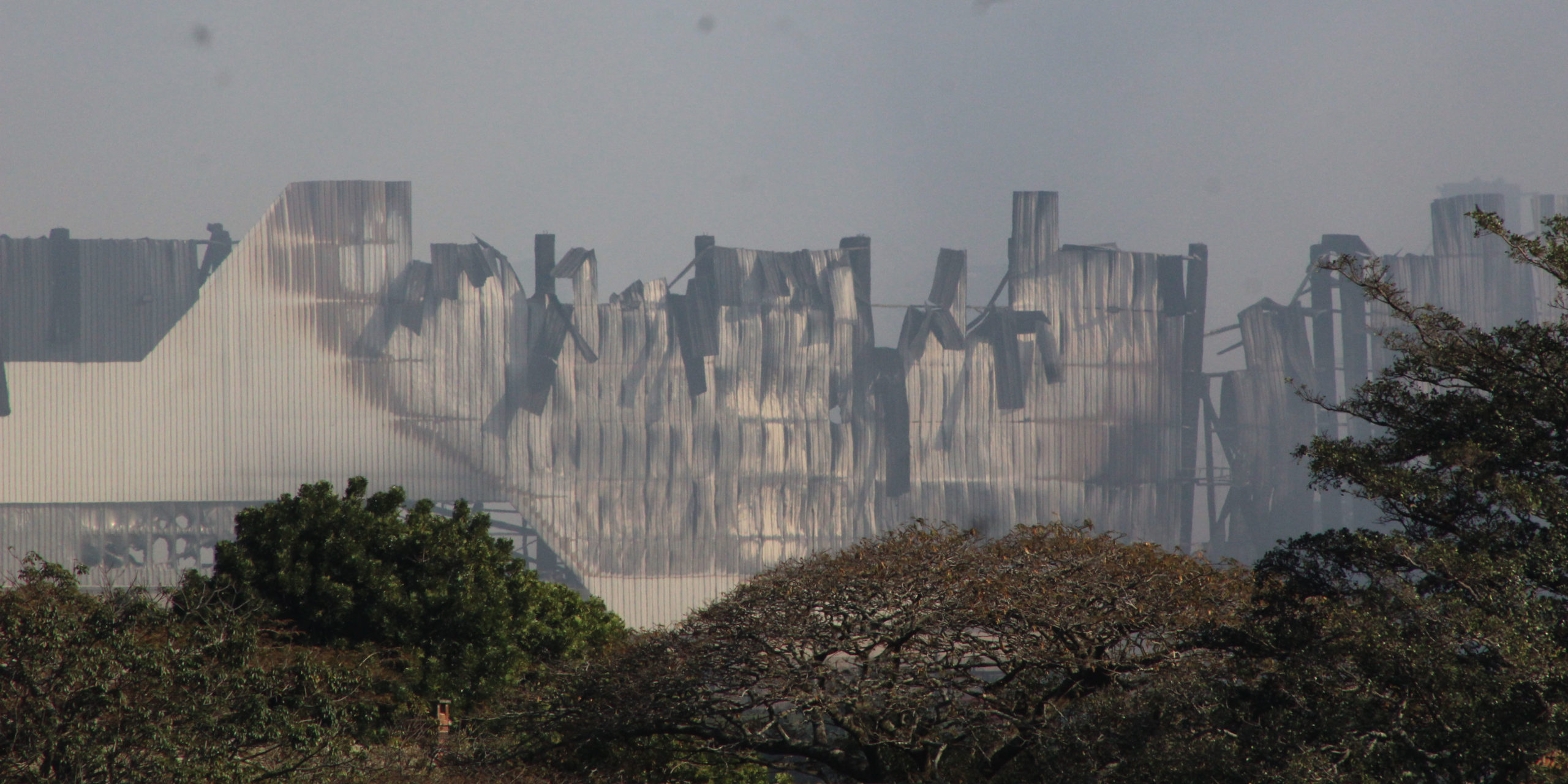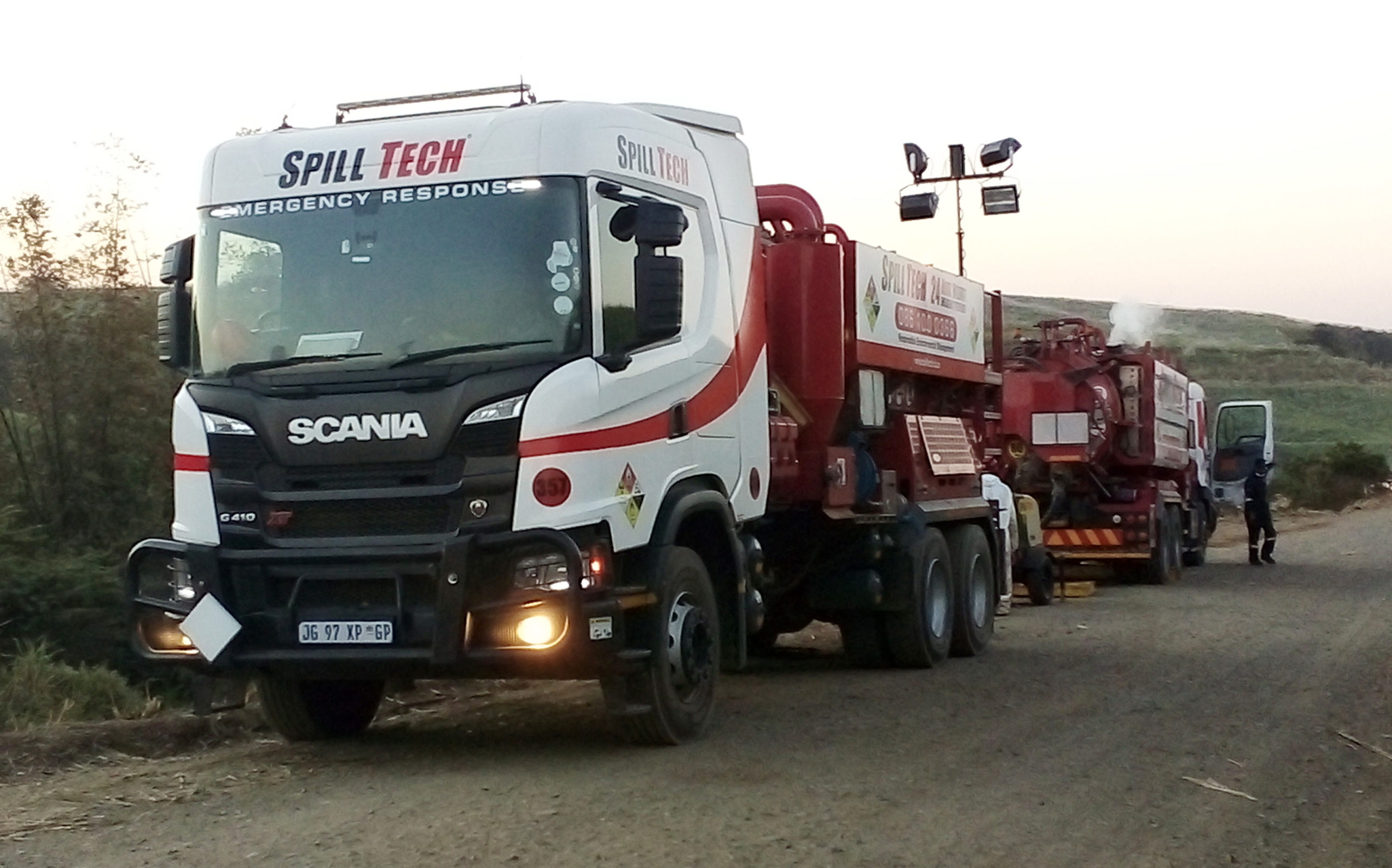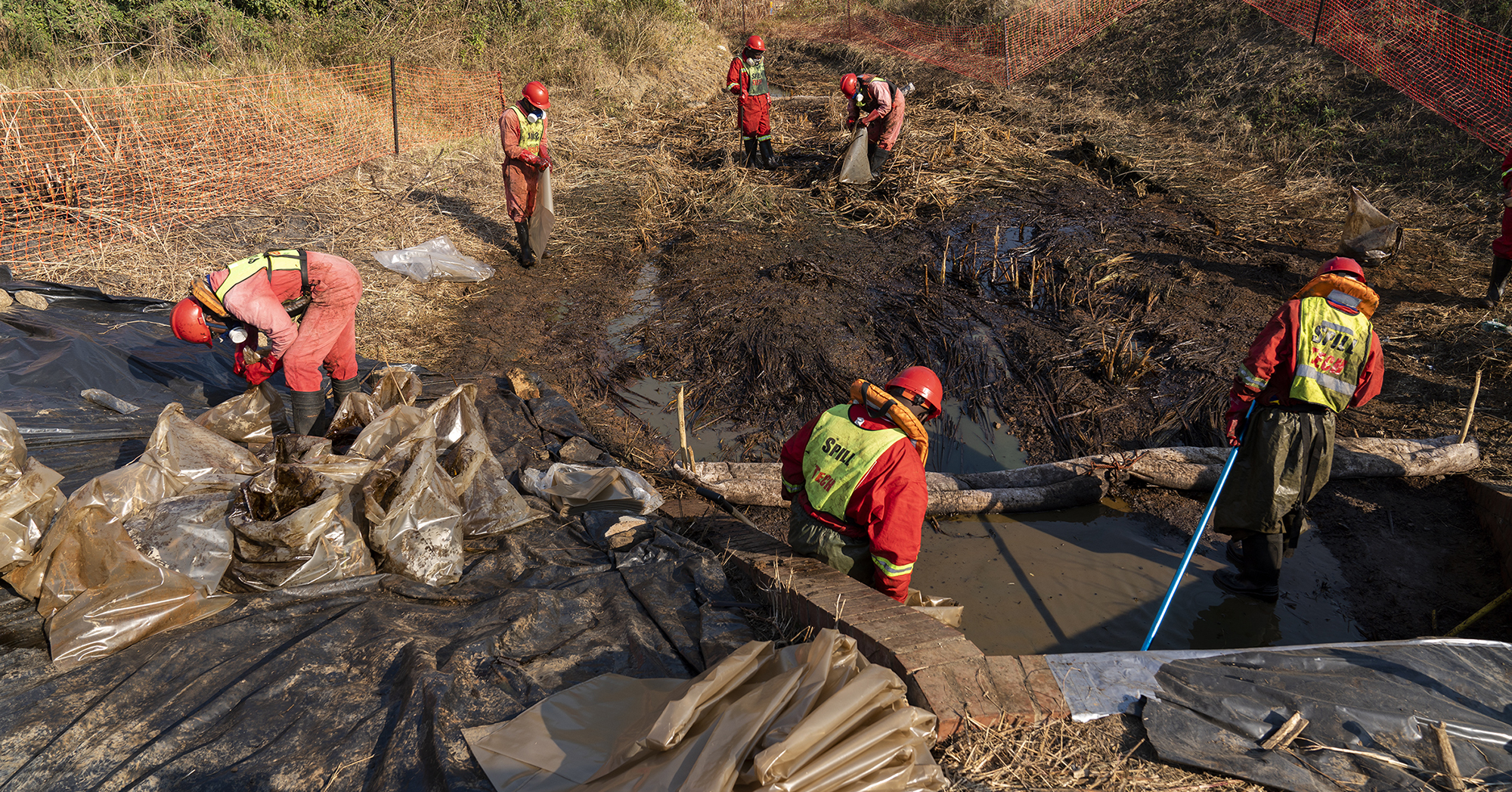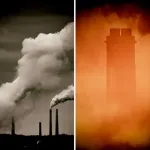Ultimately, the unseen arsonists who set the new United Phosphorus Limited (UPL) warehouse alight are responsible for exposing thousands of Durban residents to shifting toxic clouds of airborne chemicals and soot for almost 10 days (from 2am on 13 July until it was finally extinguished at 5pm on 22 July).
It was the arsonists who lit the matches or hurled the petrol bombs.
Yet, does this fact absolve the Indian agrochemicals giant from all legal responsibility or criminal prosecution for the affair due to its apparent failure to secure mandatory environmental approvals, or compliance with Major Hazardous Installation regulations, city planning by-laws and a Certificate of Registration for the storage of flammable substances?
And which way were government regulators and the warehouse property owners and developers looking while large volumes of pesticides, herbicides, fungicides and other potentially hazardous substances were being stacked up in a 14,000m2 warehouse barely 300m from a school for youngsters aged between one and 18, and about 500m from the nearest residential area?
Even taking into consideration the violent and tumultuous events in the days following the imprisonment of former president Jacob Zuma, why did it take five days for the City to issue the first rudimentary health warnings to neighbouring communities?
(UPL, for its part, has also refused repeated requests from Our Burning Planet to release a list of the quantities and types of agrochemicals it stored at the Cornubia warehouse on the basis that this would not make the potential health risks any clearer and “may instead create unnecessary anxiety”.)
Should some of the exposed residents in the northern areas of Durban have been evacuated – or should they have been warned earlier to shelter in their homes or to seal off their windows, doors or other air gaps?

Smoke and fumes pouring from the gutted remnants of the UPL pesticide warehouse in Cornubia, Durban. (Photo: Tony Carnie)
While this may seem extreme, since the exact nature of the toxicity risks of the Cornubia fire have yet to be determined, the well-known Seveso chemical factory explosion in Italy in 1976 has provided several public health lessons about the need to treat airborne chemical pollution with greater caution, as some serious health impacts may only manifest decades after airborne exposure to toxic chemicals.
For example, a review study by public health researcher, Professor Brenda Eskenazi, and colleagues in 2018 – published more than 40 years after the Seveso chemical explosion – describes measurable human health impacts varying in severity from severe acne to decreased male and female fertility among some of the Seveso residents who were exposed to high levels of 2,3,7,8-tetrachlorodibenzo-p-dioxin (TCDD) at a young age, and a possible higher risk of some cancers, especially among women.
In the Italian chemical accident, a runaway chemical reaction resulted in the release of an aerosol cloud that included sodium hydroxide, ethylene glycol, sodium trichlorophenate, and an estimated 15kg to 30 kg of TCDD over an 18km2 area. The full results of this review study can be viewed here.
Since the Seveso accident, emergency response measures in the event of chemical fires have become more stringent in several parts of the world. Last month, for example, German emergency officials told residents to stay in their homes and close their windows and doors after an explosion at a chemical plant near Leverkusen.
Police also closed several nearby local roads and motorways as a precaution, and residents were advised to rinse fruit and vegetables from their gardens before eating them.
Back in Durban – in the absence of clearer warnings from the authorities several days after the fire at UPL – local environmental health watchdogs took it upon themselves to issue an unofficial public health warning.
Desmond D’Sa, coordinator of the South Durban Community Environmental Alliance, said his group had received health-related complaints about strong chemical fumes from as far north as Ballito (almost 20km north of the UPL warehouse), along with numerous complaints from densely populated areas such as Verulam, Tongaat, Phoenix, La Lucia, Umhlanga, Blackburn and Mt Edgecombe.
“We understand that this was a deliberate arson attack – but we nevertheless believe that the company and the authorities need to be held accountable. Where are the emergency response plans? Where else in our city are large volumes of hazardous substances being kept in general warehouses that were not designed to control them safely?

Trucks belonging to waste company Spill Tech clean up after the spill from the United Phosphorus Limited warehouse in Cornubia. (Photo: Lungi Langa)
“It is only when there is a disaster, or we receive whistleblower accounts, that we hear about such places,” he said, noting that the existence of another such storage facility only came to light near Durban harbour during the July looting and arson attacks.
Shortly after the UPL fire, the Bidvest Group warned that one of its warehouses in Mobeni was also at high risk of releasing up to 500,000 litres of “extremely hazardous chemicals”, while on 1 August, the eThekwini municipality warned residents of the Hammarsdale area about “potentially harmful smoke” emanating from the still smouldering Sequence Logistics warehouse – 18 days after this fire began.
Quite apart from the potential risks to human health, inquiries by Our Burning Planet have also helped to reveal a series of apparently major failures and lapses in the environmental and regulatory approval process.
For example, no specific environmental impact assessment (EIA) appears to have been done for the UPL pesticide warehouse.
On 13 October 2015, the provincial department of economic development, tourism and environmental affairs issued a broad-scale environmental approval for the Cornubia mixed-use development scheme, for Tongaat Hulett group and the eThekwini municipality to jointly develop more than 25,000 new residential homes, several shopping areas and a smaller light industrial area (which the developers stated would be “clean and green”).
But buried within this environmental authorisation is a vital clause, which states: “Private facilities that require the storage and handling of dangerous goods that exceed 80m3 in capacity are subject to a separate EIA application prior to the construction and installation of such infrastructure.”
So who is ultimately responsible for obtaining a separate EIA for dangerous goods and other legal authorisations?
According to Tongaat Hulett spokesperson Viginia Horsley, the group sold several small parcels of Cornubia land to private developers – including the new UPL warehouse site to Fortress Income 8 on 1 November 2016, while two undivided shares for this site were finally transferred to the new owners on 10 December 2020 (about four months before the UPL pesticide site opened for business).
According to Fortress REIT chief executive Steven Brown, the company is a “responsible and ethical landowner” and had co-developed the “speculative warehouse site” after the land was acquired from Tongaat Hulett.
“The prior owner did receive the relevant EIAs prior to the sale. As one of the landlords and co-developer, we ensured the relevant environmental authorisations and impact assessments were received prior to beginning construction.
“The warehouse was a speculative build and the tenant came later. We point out that the tenants in turn had a legal obligation to obtain all of the approvals that they required in order to operate their business from the premises being rented. This is contained in our lease (which lease contained reference to the EIA) which is a contract between the landlords and the tenant.”
Notably, Brown appears to be referring to a broad-scale EIA for the entire Cornubia project rather than a site-specific EIA (which appears never to have been done).
In short, Fortress seems to suggest that it simply leased its new warehouse to UPL and bears no responsibility – even though the broad-scale EIA clearly stipulates that any private buildings for the storage and handling of goods are subject to a separate EIA “prior to the construction and installation of such infrastructure”.

Hazardous substances clean-up workers clear chemical residue from a stormwater outlet downstream from the UPL warehouse, north of Durban. (Photo: Shiraaz Mohamed)
UPL has declined to entertain any questions from Our Burning Planet on these tricky issues.
On 25 July we asked UPL whether it could provide a copy of any EIA for the storage of hazardous goods; whether it had applied for registration as a Major Hazardous Installation in terms of the Occupational Safety and Health Act or a copy of any Scheduled Trade Permit from the City of eThekwini.
In response, UPL communications consultant Craig Dodds said: “We apologise that our client is unable to provide you with a detailed response at this time. Their immediate efforts after this devastating fire caused as a result of the recent civil unrest in KZN have been directed at extinguishing the fire, containing the escape of product from the facility property, and dealing with the many tasks associated with those activities. It is a mammoth exercise involving numerous authorities, consultants and contractors, all coordinated by their small team.”
Our queries would therefore be logged and attended to in a coordinated manner at a later stage.
On 31 July, UPL issued a public statement on its website asserting that “the designed fire and containment systems were more than adequate, in ordinary circumstances, to have enabled the facility and the relevant authorities to contain a fire and any associated spillage of product”.
However, because of the significant volume of water used to extinguish the fire, and due to a “delayed response of the spill response cleaning services amid the ongoing unrest, the product that was not vaporised and the water from the fire operations overwhelmed the containment system and escaped into the environment”.
Further, it asserted: “UPL was advised, prior to opening, that the leasing and operating of a warehouse for its products did not trigger an environmental assessment under the NEMA regulations. That advice has, since the fire, been confirmed by its legal consultants.
“In relation to the risk assessment requirements under the Major Hazardous Installation (MHI) Regulations, UPL took the view that its warehouse operation did not constitute an MHI and that it did not need to conduct a risk assessment. That view has now also been confirmed by its legal consultant.
“The prospects of a cataclysmic fire, in the absence of the extraordinary circumstances that occurred in this instance, was extremely low… UPL takes seriously its responsibility for its products, regardless of the fact that the event was entirely beyond its control.”
In short, UPL appears to suggest that it did everything it was required to.
But, hang on, asked Our Burning Planet on 3 August: What was the exact design volume of the “more than adequate” water containment system at the warehouse? No response.
Who advised UPL that it did not need an EIA? Could UPL provide a copy of this advice – as well as a copy of the subsequent legal opinion it received to this effect. No response.
Who in UPL took the initial decision that no MHI application was necessary, and could UPL also make available a copy of the subsequent signed legal opinion to substantiate this assertion? No response.
Now that three weeks had elapsed from the start of the fire, would UPL now disclose publicly the total volume of the chemical stocks listed in its Cornubia warehouse inventory just prior to the arson attack? No response.
Would UPL dispute information received by Our Burning Planet that the volume of products stored at Cornubia in fact amounted to several thousand tons of a variety of more than 1,600 agrochemical substances? No response.
DM/OBP




















 Become an Insider
Become an Insider
The annoying part is that ordinary sites get hounded about regulations some of which are simply insane.
I recently had an inspector tell me that it would be more hazardous to store 5 plastic bins with bottled wine (4000 liters of non flammable liquid per sqm stored in about equivalent of 1.5 liters of plastic) than 2 bins as the rule says anything in plastic is only 2 meters high. It was like a Monty Python movie. They went on to demand sprinklers in a wall to ceiling tiled bathroom with the princely sum of three toilet rolls flammable…
For size of three times that Durban warehouse we have about 500,000 liters of backup reservoir (in case two enormous council 6 bar supplies fail). So in a severe fire event of 200sqm you have two meters deep of water deluge (besides council). Besides, high hazard sprinklers will NOT be overwhelmed by a petrol bomb in one place unless the stored goods are themselves even more concentrated energy stores than petrol and the fire spreads faster than adjoining sprinklers get triggered. Whatever they had there was much more incendiary than petrol, or the sprinkler system failed or the system was far under spec.
As if Beirut isn’t a good enough example?
That was my first thought on reading this as Lebanon mourned their losses one year later on 4 August.
What does Minister Barbara Creecy have to say about this? The warehouse should be closed down and heads must roll – or am I too optimistic?